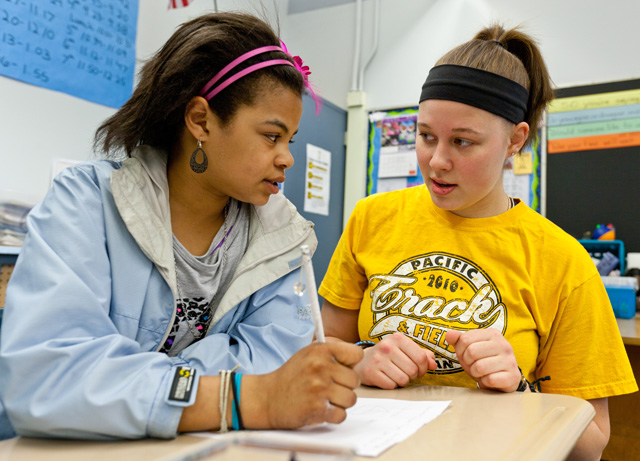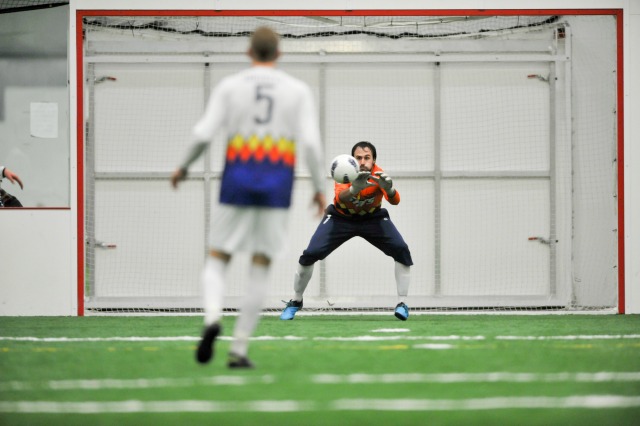Page 136 • (1,514 results in 0.05 seconds)
-
April 25, 2008 AAUP president discusses faculty leadership Campus Voice spoke with Cary Nelson, president of the American Association of University Professors, prior to his campus address in April. The interview has been edited for length. Campus Voice: What is the role of the president of the American Association of University Professors? Cary Nelson: First of all it is to be a spokesperson for the organization. I’d been writing about higher education policies for about 20 years before I
-

the two go over the math problem, “and then just show your work by writing it out.” Figuring out the area of a shape takes steps, Melissa Castor tells the students. Her role in Denise Allen’s class is to assist the students while Allen teaches the material. Castor ‘14 is one of about 25 PLU students who volunteer their time at the Franklin Pierce school that is a neighbor to PLU, as part of Club Keithley. “My students have benefited so much by having them in my classes to help,” Allen said. “My
-

two go over the math problem, “and then just show your work by writing it out.” Figuring out the area of a shape takes steps, Melissa Castor tells the students. Her role in Denise Allen’s class is to assist the students while Allen teaches the material. Castor ‘14 is one of about 25 PLU students who volunteer their time at the Franklin Pierce school that is a neighbor to PLU, as part of Club Keithley. “My students have benefited so much by having them in my classes to help,” Allen said. “My
-

… sometimes you have to fall out of favor with what you love to really appreciate it.” Sports always has been a huge part of Croft’s life, and as he grew up, he found a way to merge it with another passion: writing. At Inglemoor High School in Kenmore, Wash., Croft wrote about sports, and at PLU he was a Journalism major who wrote and edited for The Mast. After graduation, though, newspaper jobs were few and far between—and Croft missed soccer. “I connected with an old club coach, who got me onto a couple
-

station, it was difficult in the beginning to keep up. This story didn’t just change daily, it changed hourly. That creates logistical challenges when writing and producing for broadcast, to keep your coverage relevant and up-to-the-minute. As a digital journalist for our station, I leaned heavily on social media sharing and web-first reporting in the beginning. As numbers of COVID-19 cases grew, and the scope of those affected changed, we adapted to take a big-picture approach. Our top priority now
-

grant as a way to finish what she started — both with her research and music interests. She poured nearly a year into writing a thesis and gathering letters and endorsements from faculty both at PLU and in Namibia before submitting an application in October. She waited three months before finding out she was a semi-finalist, then another three months before finding out she was a finalist in April. Each year nearly 5,000 applications are submitted annually from students and faculty nationwide. The
-
assessment should be conducted. The hazard assessment or review must be documented, in writing or electronic form and approved by the Environmental Health & Safety Manager. The hazard assessment must contain the following information: Name of the Department Name of person certifying that a workplace hazard assessment was done Date(s) the workplace hazard assessment was done Statement identifying the document as the certification of hazard assessment of PPE for the workplace Sample evaluation forms can be
-
letter writers and mentors, letting them know you’re still passionate about attending grad/med/dental school, and filling them in about your recent and current activities, updated test scores, triumphs and struggles, and other things you have been doing to strengthen your application. You cannot be involved in the drafting or writing of your recommendation letter. If your letter writer asks you to write a letter for them to sign, run. Decide whether or not to waive your right to access the letter of
-
intended to demonstrate competency in grammar and composition as well as comprehension and analysis of written work. In general, the English requirement is met by taking courses that medical schools would recognize as writing or literature courses. Chemistry Courses Take the following two-course sequence in general chemistry: CHEM 115 (General Chemistry I)* CHEM 116 (General Chemistry II) Take the following two-course sequence in organic chemistry: CHEM 331/333 (Organic Chemistry I + laboratory) CHEM
-
intended to demonstrate competency in grammar and composition as well as comprehension and analysis of written work. In general, the English requirement is met by taking courses that medical schools would recognize as writing or literature courses. Chemistry Courses Take the following two-course sequence in general chemistry: CHEM 115 (General Chemistry I)* CHEM 116 (General Chemistry II) Take the following two-course sequence in organic chemistry: CHEM 331/333 (Organic Chemistry I + laboratory) CHEM
Do you have any feedback for us? If so, feel free to use our Feedback Form.


